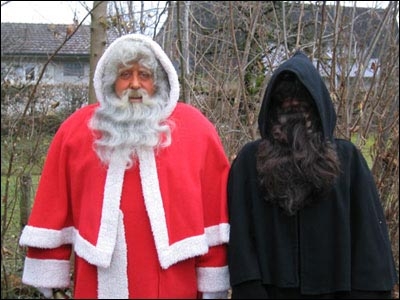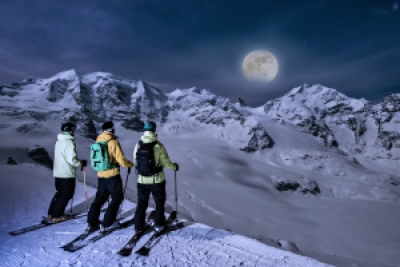- Trips
- Tour Calendar
- About Our Tours
- Plan a Trip
- Book a Trip
- About Us
- Contact Us



If you find yourself travelling in Switzerland at Christmas time you may wonder where Santa is. Did he skip the Alps this year? Of course not. Santa comes to Switzerland like clockwork. Every year. It’s just that he arrives on December 6th, for “Samichlaus Abend”—Santa Night. “Samichlaus,” as he is known in Switzerland, wears a hooded red cape and long robe so he looks like an elderly version of Little Red Riding Hood. His arrival marks the beginning of the Christmas season. And it’s easy for him to make his entrance into town. Samichlaus comes from a nearby forest rather than the North Pole. Children quickly gather as he arrives alongside a donkey. No flying reindeer for this Santa. A benevolent gift-giver, he brings a bag of treats for the children.

But Samichlaus doesn’t come alone. When he strides into town right before December 6, he brings a mysterious sidekick, “Schmutzli” (“little dirty one”), whose face is hidden beneath a dark and heavy hooded cape. He is in charge of “punishing” disobedient children by swatting them with a broom made of twigs. But everyone recognizes it’s all in fun. Schmutzli remains silent and mysterious as he travels with Samichlaus. They often journey with a donkey or handcart to carry their treats. Samichlaus interviews the children on their behavior in the past year and tries to get a commitment for improvement for the year ahead. Then the traditional treats of lebkuchen, chocolates, peanuts and mandarins are delivered by the iconic pair. And one more tasty treat is included—a little bread man or grittibänz—an absolutely essential part of the tradition.

The Christmas Season Begins
Some villages have dramatic processionals special events to acknowledge St Nicholas Day. In almost all markets across Switzerland, Samichlaus and Schmutzli will visit to distribute treats and keep the tradition alive. Bright colors, loud noises, clanging cowbells, glowing candles, and bellowing trumpets create a festive atmosphere as well as scare away evil spirits that lurk during the dark days of winter. The most elaborate and best known of these processions is the Klausjagen held on December 5 in the town of Küssnacht on the Vierwaldstättersee (Lake Luzern).

December 24 is “Heiliger Abend,” Christmas Eve or Holy Night, and is celebrated according to the traditions of each village and valley. Most are closely connected to the religious beliefs of the community. In the 16th century, as part of the Reformation, many Swiss villages chose to align themselves with either Catholic or Reform beliefs which affects the Christmas traditions they practice today.
The Christmas tree, which may have been freshly cut by hand, is often hidden away until after dinner and then is revealed after a festive meal on Christmas Eve. Gasps of delight accompany the moment the children see the tree adorned with apples, bells, snowflakes, and sugar cookies in festive shapes. Many families still maintain the tradition of adorning their Christmas tree with lit candles which makes the moment all the more memorable. The story of the Nativity is retold and the family sings the favorite alpine Christmas carol, “Stille Nacht,” which originated in neighboring Austria. Then there is the hunting for hidden presents, most being simple and highly practical. The special night is usually capped by attendance at Midnight Mass where there is plenty of bell ringing and carol singing.
A belief widely held in some regions of Switzerland is that on the First Christmas animals were given the power to speak. A tradition then developed that the miracle is repeated each year at midnight on Christmas Eve in gratitude for the service given by the animals surrounding the Christchild. Farm animals are given an extra portion of hay or grain on Heiliger Abend so no one will accidentally overhear the animals speaking and thus invite a year of bad luck.

With mountain snowfall in abundance, Christmas Day begins the winter sports season. Many head for ski resorts and or mountain chalets to try their hand at tobogganing, skiing, ice skating, Nordic skiing and bobsledding. Many chilly evenings conclude with delicious fondue.
Especially in the small alpine villages, the week between Christmas and New Year’s Day is the time to visit neighbors and family. And all the delicious holiday pastries and cookies are on hand to continue the celebration.
Try your hand at baking some Baumnuss Guetzli, which are a type of walnut cookie. While the cookies are in the oven you can sign up for a Swiss Christmas Market Tour.